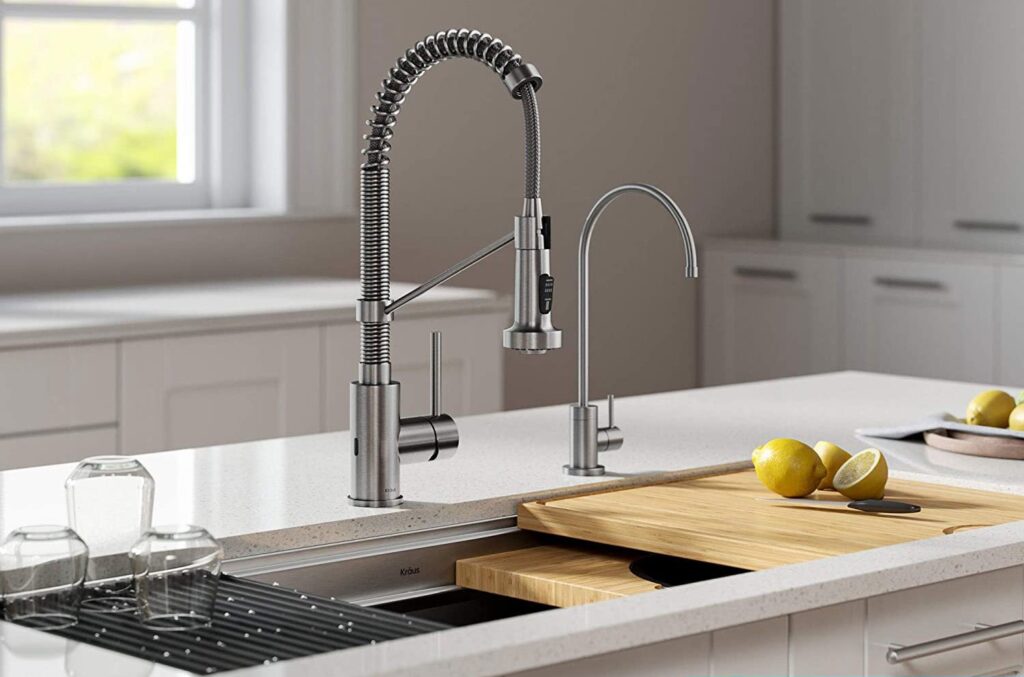If you are considering a new style faucet, you have a big decision to make: Does a “touch” faucet or “touchless” faucet make more sense?
At James River Construction (JRC)

You’ve probably heard or seen about the newer, more advanced kitchen faucets on the market. Delta Faucet was the first to introduce the world to the “touch faucet” back in 2008 – a faucet that you can turn on and off with a simple tap. Since then, many other companies have joined Delta in providing high-end touch faucets – companies such a Brizo, Moen, and Kohler. These interesting products (touch and touchless) offer different functions and benefits. Both provide a newer, higher tech feel for your renovated kitchen or bathroom. If you are considering a new style faucet, you have a big decision to make: Does a “touch” faucet or “touchless” faucet make more sense?
Join us on our journey to discuss the big differences and intricacies of each!
TOUCH FAUCETS – BENEFITS AND DRAWBACKS
How Do Touch Faucets Work?
These faucets work very much like the screen on your smart phone. They are equipped with capacitive sensors that can detect the electric current that our bodies generate. So, when you touch the faucet with your hand, or elbow, or nose, the sensor detects your charge, and turns on the faucet. The faucet can also sense whether you are touching the faucet in order to turn it on vs just to adjust where the faucet pours.
Benefits of Touch Faucets
You know how messy things can get when you’re cooking at home. With a regular faucet, that mess ends up on the knob/lever too – just adding to the cleanup. With a touch faucet, you can just use the back of your hand or any body part that is clean, in order to keep that mess contained (and off the faucet).
The main benefit with a touch faucet is convenience. Since many cooking and kitchen related tasks require both hands, you no longer have to drop whatever you’re holding to turn on (or off) the faucet.
Drawbacks of Touch Faucets
Even if you are a skilled “DIY” expert, you should strongly consider having an experienced professional install a touch faucet. They require a power source (batteries/sockets) to run, and as you know, water and electricity don’t mix. A loose seal or makeshift solution can cause a ton of problems in the long run.
The cost of a touch faucet generally runs more than a traditional faucet (of course, every faucet is different), both upfront and for maintenance. If your touch faucet takes batteries, you’ll need to change them out somewhat regularly. If your touch faucet is hard wired, you can expect your power bills to be a touch higher (not by much, though).
TOUCHLESS FAUCETS – BENEFITS AND DRAWBACKS
How Do They Work?
As is always the case with new technology, Delta came out with a newer, even more advanced faucet option, the “touchless” faucet, for residential use in 2011. Motion/Optical sensors installed in the base of the touchless faucet “see” the required movements to turn your touchless faucet on and off. Much like their touch faucet analogs, these faucets are smart enough to tell the difference between turning it on and off, and simply adjusting the faucet neck/hose (most of the time… see the “drawbacks” below)
Benefits of Touchless Faucets
Touchless faucets have all the pros of touch faucets, but with the added convenience of not having to actually touch the system itself. That means less mess, less fuss, and a more convenient experience.
Drawbacks of Touchless Faucets
Touchless faucets are generally even more expensive than touch faucets, and they require the same amount of professional oversight during installation. They too require batteries or hard wiring into your power source, which adds to the total operating cost over time.
Touchless faucets also are more prone to accidental operation. These motion and optical sensors see movements and are generally smart enough to differentiate these movements, but no technology is perfect (especially in its early stages of development). Expect that a touchless faucet will occasionally shoot out water when you’re near it and doing something else.
Finally, the more bells and whistles and sensors, the more prone they are to needing replacement. This could leave to additional expenses down the road.
SOME THINGS TO CONSIDER, HOWEVER YOU CHOOSE:
What type of countertop is it being installed on?
Certain materials, like quartz, can cause issues with the sensors on these faucets. While quartz is clean, elegant, and beautiful. However, it sometimes contains enough metal to carry a capacitive charge from the counter/backsplash to the sensor, which can turn it on accidentally… especially when the quartz is too close to the faucet itself. Obviously, it’s best to double and triple check that this won’t happen to you!
Choose Professional Installation and Be Prepared to Make Adjustments
One thing is for sure: these aren’t your granddaddy’s faucets! They are full of parts and pieces, need to be powered (and you know that electricity and water don’t mix), and therefore require a skilled installer. With that many moving parts, there’s just more chances for something to sideways. Don’t let that scare you off though! We love these faucets, and many of us have them in our personal homes. Just be aware that you’ll need a pro to install it, and it might need some adjustments before the desired level of functionality is reached.
The Bottom Line
Really, you can’t go wrong with any faucet that you choose as long as you’ve done your research and you install (or have it installed) the right way. Keep in mind, there’s nothing wrong with the classic faucet either. We recommend you consider your options, talk to the experts (we are always available) and make an educated decision.
